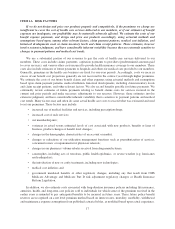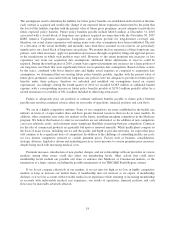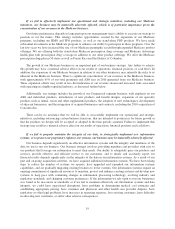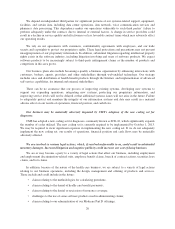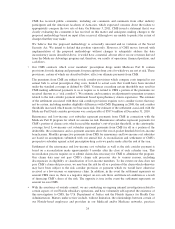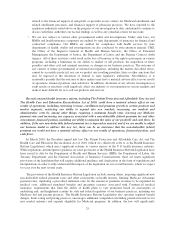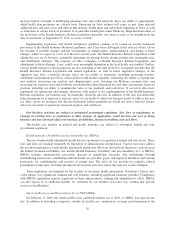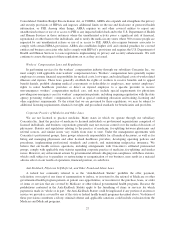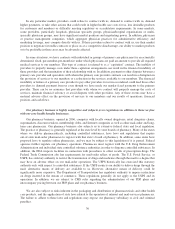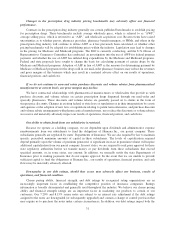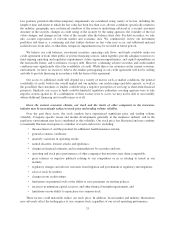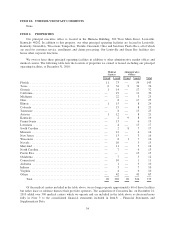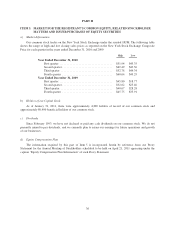Humana 2010 Annual Report Download - page 36
Download and view the complete annual report
Please find page 36 of the 2010 Humana annual report below. You can navigate through the pages in the report by either clicking on the pages listed below, or by using the keyword search tool below to find specific information within the annual report.increase federal oversight of health plan premium rates and could adversely affect our ability to appropriately
adjust health plan premiums on a timely basis. Financing for these reforms will come, in part, from material
additional fees and taxes on us and other health insurers, health plans and individuals beginning in 2014, as well
as reductions in certain levels of payments to us and other health plans under Medicare. Implementation dates of
the provisions of the Health Insurance Reform Legislation generally vary from as early as six months from the
date of enactment, or September 23, 2010, to as late as 2018.
Implementing regulations and related interpretive guidance continue to be issued on several significant
provisions of the Health Insurance Reform Legislation, and it has been challenged in the judicial system. Given
the breadth of possible changes and the uncertainties of interpretation, implementation, and timing of these
changes, which we expect to occur over the next several years, the Health Insurance Reform Legislation could
change the way we do business, potentially impacting our pricing, benefit design, product mix, geographic mix,
and distribution channels. The response of other companies to Health Insurance Reform Legislation and
adjustments to their offerings, if any, could cause meaningful disruption in the local health care markets. Further,
various health insurance reform proposals are also emerging at the state level. It is reasonably possible that the
Health Insurance Reform Legislation and related regulations, as well as future legislative changes, in the
aggregate may have a material adverse affect on our results of operations, including restricting revenue,
enrollment and premium growth in certain products and market segments, restricting our ability to expand into
new markets, increasing our medical and administrative costs, lowering our Medicare payment rates and
increasing our expenses associated with the non-deductible federal premium tax and other assessments; financial
position, including our ability to maintain the value of our goodwill; and cash flows. If we fail to effectively
implement our operational and strategic initiatives with respect to the implementation of the Health Insurance
Reform Legislation, our business may be materially adversely affected. In addition, if the new non-deductible
federal premium tax is imposed as enacted, and if we are unable to adjust our business model to address this new
tax, there can be no assurance that the non-deductible federal premium tax would not have a material adverse
effect on our results of operations, financial position, and cash flows.
Our business activities are subject to substantial government regulation. New laws or regulations, or
changes in existing laws or regulations or their manner of application, could increase our cost of doing
business and may adversely affect our business, profitability, financial condition, and cash flows.
The health care industry in general and health insurance are subject to substantial federal and state
government regulation:
Health Insurance Portability and Accountability Act (HIPAA)
The use of individually identifiable health data by our business is regulated at federal and state levels. These
laws and rules are changed frequently by legislation or administrative interpretation. Various state laws address
the use and maintenance of individually identifiable health data. Most are derived from the privacy provisions in
the federal Gramm-Leach-Bliley Act and the Health Insurance Portability and Accountability Act, or HIPAA.
HIPAA includes administrative provisions directed at simplifying electronic data interchange through
standardizing transactions, establishing uniform health care provider, payer, and employer identifiers and seeking
protections for confidentiality and security of patient data. The rules do not provide for complete federal
preemption of state laws, but rather preempt all inconsistent state laws unless the state law is more stringent.
These regulations set standards for the security of electronic health information. Violations of these rules
could subject us to significant criminal and civil penalties, including significant monetary penalties. Compliance
with HIPAA regulations requires significant systems enhancements, training and administrative effort. HIPAA
can also expose us to additional liability for violations by our business associates (e.g., entities that provide
services to health plans).
American Recovery and Reinvestment Act of 2009 (ARRA)
On February 17, 2009, the American Recovery and Reinvestment Act of 2009, or ARRA, was enacted into
law. In addition to including a temporary subsidy for health care continuation coverage issued pursuant to the
26



